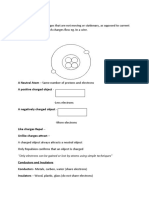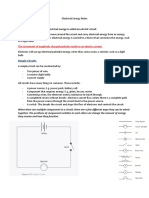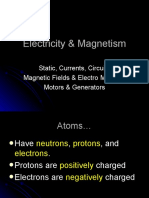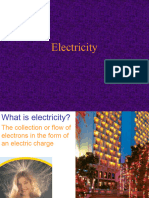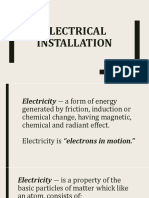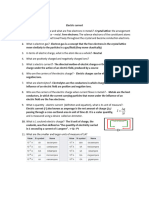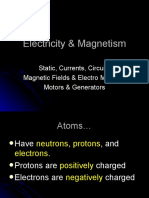Physics Notes
Uploaded by
siri099.gummiPhysics Notes
Uploaded by
siri099.gummiScience Notes: Physics
Electric Energy: Topic 1
Subatomic Particles
- Electrons have a negative charge
- Protons have a positive charge
- Neutrons have a neutral charge
- Unlike charges attract to one another
- Like charges repel one another
Potential Energy
- Potential energy is the energy stored in an object relative to something else
- Relative means the same as saying ‘in comparison to’
- Electrical Potential energy is determined by the relative difference in strength of
positive and negative charges and is also dependant on the distance between the
charges
- The harder it is to separate the two opposite charges, the more potential energy
there is between them. The further apart, the more potential energy
- Static Electricity is a build of unbalanced charge in one area
Simple Circuits: Topic 2
What does a Simple Circuit need?
- A supply of energy (power supply / battery)
- A closed loop for the current to flow through
(switch)
- Somewhere to drop that energy / something to
power (load)
Power Supply (Batteries)
- The long line of a cell is the positive side, and the short side is
the negative side
- A cell has only one positive and negative side, whereas a battery
has at least two cells
- Batteries separate electrons from their home atoms by moving
them to one side leaving the protons on the other side; this
creates potential difference
- The electrons stay on the negative side of the battery and are stopped from going to
the positive side by a barrier, this means they have to use an alternative path.
- Connecting a conductor to both terminals helps the electrons to reunite with the
protons and the battery continues to strip electrons from their atoms
Loads
- If a circuit only has a power supply and conductor, it is called a short circuit
- Since the electrons gain more energy everytime they cross the battery since there is
nowhere for the energy to go, they just move faster and faster which will either
cause the battery to drain quickly or the wire to get hot.
- Loads take up all the extra energy from the electrons and prevent wire to get hot, the
battery to die and explosions or fires.
Current and Voltage in Simple Circuits
- The 3 properties that are usually measured
in a circuit are Voltage, measured in Volts
(V), Current, measured in Amps (A), and
Resistance, measured in Ohms (Ω)
- Current is the flow of electrons in a circuit
and it remains constant through a circuit,
the same number that go in come out.
- Ammeters are used to measure the current
in an electrical circuit. They measure the
number of electrons flowing through a
particular point in the circuit, to do this
they have to be made a part of the circuit
- This is called placing the ammeter in series to the lightbulb and is done by breaking
the circuit and placing the ammeter in its place
- Conventional Current flows in the direction a positive charge would move, so from
positive to negative which is opposite to the direction of electron flow
- Voltage is the power each electron carries to the load and
then it goes back to the battery empty to recharge
- Voltage is another word for potential difference in the
circuit and it is produced by the battery.
- The bigger the difference between the positive and negative
terminals, the bigger the potential difference, the bigger the
voltage.
- Electrons are trying to move to the positive side, so the
more voltage/potential difference the more power they
flow with; voltage is power
- Voltage is measured using a voltmeter and it measures by
being connected to two different areas in the circuit to
measure the potential difference, it must be positioned in parallel to the lightbulb
- To use a voltmeter to test the voltage (V) difference between two points in a circuit
using a multimeter:
-> plug the black probe into COM plug and the red into the V/Ω/mA plug
->turn dial to the V section
->The number represents the max possible reading on the setting
->touch the probes on either side of the part in which you want to measure voltage
- To test the current through a point in in the circuit using a multimeter:
->plug the black probe into COM plug and the red into the 10ADC plug
->turn the dial to the A section with straight lines
->the number represents the maximum possible reading, start on the lowest setting
and keep going till you see a number
->break your circuit and pass it through your probes making them a part of the circuit
Series and Parallel Circuits: Topic 3
- Series and Parallel Circuits
are much more complicated
than simple circuits and can
be found in your phone,
switches and anywhere else
in your house.
- In a Series circuit, all of the loads and batteries are all next to each other, one after
the other in one line
- When loads are set up in a Parallel Circuit, it means that the wires that they have
been set up with are parallel to each other.
Resistance: Topic 4
Conductors and Insulators
- A conductor is something that electrons can flow through and create electricity easily
whereas an insulator is the opposite. (e.g. a metal (copper) is a good conductor, a
metalloid (silicon) is a semiconductor and a nonmetal (glass) is an insulator.
- A good conductor has to have electrons that are available to move. Metals have a
‘sea of delocalised electrons’ that can move freely.
- Insulators such as rubber and glass do not have free electrons in their structure, so
current cannot flow through it.
- Insulators provide protection, efficiency and also prevent damage
Resistance
- Resistance still occurs even in very good
quality conductors
- Resistance is the friction encountered by
an electron as it moves through a circuit
- When resistance is high, electrons move
slower, making the current reduce
- A thin wire has more resistance as there is
less space for the electrons to move
freely, whereas a thick wire has lower
resistance as it has more space for the
electrons to move.
- The unit used for resistance is Ohms (Ω).
- In a series circuit, to find the resistance
you just have to add all of the Ohms of the
resistors together. Resistors in a series circuit Increases the resistance of a circuit
- Resistors in a parallel circuit decrease the resistance in the circuit. It is found by the
formula above.
- If all resistors have the same resistance in a parallel circuit, get the resistance of one
resistor and divide the number by the number of resistors in the parallel circuit to get
the total resistance
Ohm’s Law:
- Ohm’s law states that “Voltage is directly proportional to
the current, when the resistance is constant”
- V=IxR
-> V = voltage (volts)
-> I = current (amps)
-> R = Resistance (ohms)
Magnetism and Electric Currents: Topic 5
Magnetism
- Magnets were discovered by the Ancient Greeks, who noticed
that certain rocks (‘Lodestones’) could attract metals from far
away, and when hung from a string it would always point
towards the Polaris, the North Star
- Magnetism in the modern world is a field which extends into
space, and magnetisable materials such as metals try to align
themselves within this field.
- In 1820, Hans Christian Oersted found out that electricity and
magnetism are linked
- Oersted had shown that electric currents produce magnetic
fields.
- The method used most often to create an electromagnet is by wrapping a wire over a
piece of metal many times. This is also known as a solenoid, which can be found in
cars, electric locks, MRI machines and speakers.
- Few years later Michael Faraday showed that electric currents can also feel magnetic
forces.
- Then it was discovered that electric currents could exactly mimic magnets. This was
named as ‘Electromagnetism’
You might also like
- Fundamentals of Automotive Electricity & ElectronicsNo ratings yetFundamentals of Automotive Electricity & Electronics81 pages
- Only Electrons Can Be Gained or Lost by Atoms Using Simple TechniquesNo ratings yetOnly Electrons Can Be Gained or Lost by Atoms Using Simple Techniques18 pages
- Electricity & Magnetism: Static, Currents, Circuits Magnetic Fields & Electro Magnets Motors & Generators100% (2)Electricity & Magnetism: Static, Currents, Circuits Magnetic Fields & Electro Magnets Motors & Generators27 pages
- Electricity Magnetism and ElectromagnetismNo ratings yetElectricity Magnetism and Electromagnetism64 pages
- JC-Learn: Science Notes Current ElectricityNo ratings yetJC-Learn: Science Notes Current Electricity8 pages
- Topic 1 - Basic Electrical - ElectronicNo ratings yetTopic 1 - Basic Electrical - Electronic144 pages
- CHAPTER 1 - Basic Electrical PrinciplesNo ratings yetCHAPTER 1 - Basic Electrical Principles42 pages
- Principles of Electricity: Background To Electricity, Circuits, and How To CalculateNo ratings yetPrinciples of Electricity: Background To Electricity, Circuits, and How To Calculate22 pages
- KS3 Topic Revision Electricity and MagnetismNo ratings yetKS3 Topic Revision Electricity and Magnetism20 pages
- Grade 9 - Term 2 - Physics Revision SheetNo ratings yetGrade 9 - Term 2 - Physics Revision Sheet27 pages
- Electricity: Prepared By: Puan Farizah Binti Ariffin50% (2)Electricity: Prepared By: Puan Farizah Binti Ariffin49 pages
- Definition of Terms in Electrostatics and Electricity and MagnetismNo ratings yetDefinition of Terms in Electrostatics and Electricity and Magnetism4 pages
- Module 5 - Energy and Electricity ConservationNo ratings yetModule 5 - Energy and Electricity Conservation6 pages
- Budget Course Outline: Department of EducationNo ratings yetBudget Course Outline: Department of Education2 pages
- M100 Filters: The Most Efficient Hydraulic Filters That Require No External Power SourceNo ratings yetM100 Filters: The Most Efficient Hydraulic Filters That Require No External Power Source6 pages
- Ramchandra Dwivedi Rachnavali - Edited by Surya Prakash Vyas100% (1)Ramchandra Dwivedi Rachnavali - Edited by Surya Prakash Vyas255 pages
- Configure ML-1660 For CUPS - Page 2 - UbuntuNo ratings yetConfigure ML-1660 For CUPS - Page 2 - Ubuntu4 pages
- Process Mapping and Value Stream MappingNo ratings yetProcess Mapping and Value Stream Mapping24 pages
- (Ebook) Dark Goddess Craft: A Journey Through the Heart of Transformation by Woodfield, Stephanie ISBN 9780738752563, 9780738754079, 0738752568, 0738754072 all chapter instant downloadNo ratings yet(Ebook) Dark Goddess Craft: A Journey Through the Heart of Transformation by Woodfield, Stephanie ISBN 9780738752563, 9780738754079, 0738752568, 0738754072 all chapter instant download65 pages
- Workbook - Communicating With Tact and Finesse100% (1)Workbook - Communicating With Tact and Finesse11 pages
- Construction Project Schedule Template G1 Residential BuildingNo ratings yetConstruction Project Schedule Template G1 Residential Building4 pages
- HDFC Bank Millennia Credit Card: Inspired Living, Ready For YouNo ratings yetHDFC Bank Millennia Credit Card: Inspired Living, Ready For You3 pages
- Unsupervised Learning of Video Representations Using LstmsNo ratings yetUnsupervised Learning of Video Representations Using Lstms12 pages
- IT Project Management 2023-2024_Final AssignmentNo ratings yetIT Project Management 2023-2024_Final Assignment4 pages
- Knowledge, Attitudes, and Practices (Kap) Surveys During Cholera Vaccination Campaigns: Guidance For Oral Cholera Vaccine Stockpile CampaignsNo ratings yetKnowledge, Attitudes, and Practices (Kap) Surveys During Cholera Vaccination Campaigns: Guidance For Oral Cholera Vaccine Stockpile Campaigns41 pages
- U of H Open Records Complaint To Texas Attorney GeneralNo ratings yetU of H Open Records Complaint To Texas Attorney General21 pages
- Lecture 3 - Bohr Models - Success and Its FailureNo ratings yetLecture 3 - Bohr Models - Success and Its Failure31 pages
- Toxic Masculinity and Gender Equity in The Australian Defence ForceNo ratings yetToxic Masculinity and Gender Equity in The Australian Defence Force3 pages
- Moving Charges and Magnetism-Ii Puc PDFNo ratings yetMoving Charges and Magnetism-Ii Puc PDF23 pages
- Detecting Fake News Using Machine Learning: Gaurav Kumar Choubey (21mca1061) Guide Name: DR Rajarajeswari SNo ratings yetDetecting Fake News Using Machine Learning: Gaurav Kumar Choubey (21mca1061) Guide Name: DR Rajarajeswari S29 pages
- Fundamentals of Automotive Electricity & ElectronicsFundamentals of Automotive Electricity & Electronics
- Only Electrons Can Be Gained or Lost by Atoms Using Simple TechniquesOnly Electrons Can Be Gained or Lost by Atoms Using Simple Techniques
- Electricity & Magnetism: Static, Currents, Circuits Magnetic Fields & Electro Magnets Motors & GeneratorsElectricity & Magnetism: Static, Currents, Circuits Magnetic Fields & Electro Magnets Motors & Generators
- Principles of Electricity: Background To Electricity, Circuits, and How To CalculatePrinciples of Electricity: Background To Electricity, Circuits, and How To Calculate
- Electricity: Prepared By: Puan Farizah Binti AriffinElectricity: Prepared By: Puan Farizah Binti Ariffin
- Definition of Terms in Electrostatics and Electricity and MagnetismDefinition of Terms in Electrostatics and Electricity and Magnetism
- M100 Filters: The Most Efficient Hydraulic Filters That Require No External Power SourceM100 Filters: The Most Efficient Hydraulic Filters That Require No External Power Source
- Ramchandra Dwivedi Rachnavali - Edited by Surya Prakash VyasRamchandra Dwivedi Rachnavali - Edited by Surya Prakash Vyas
- (Ebook) Dark Goddess Craft: A Journey Through the Heart of Transformation by Woodfield, Stephanie ISBN 9780738752563, 9780738754079, 0738752568, 0738754072 all chapter instant download(Ebook) Dark Goddess Craft: A Journey Through the Heart of Transformation by Woodfield, Stephanie ISBN 9780738752563, 9780738754079, 0738752568, 0738754072 all chapter instant download
- Construction Project Schedule Template G1 Residential BuildingConstruction Project Schedule Template G1 Residential Building
- HDFC Bank Millennia Credit Card: Inspired Living, Ready For YouHDFC Bank Millennia Credit Card: Inspired Living, Ready For You
- Unsupervised Learning of Video Representations Using LstmsUnsupervised Learning of Video Representations Using Lstms
- Knowledge, Attitudes, and Practices (Kap) Surveys During Cholera Vaccination Campaigns: Guidance For Oral Cholera Vaccine Stockpile CampaignsKnowledge, Attitudes, and Practices (Kap) Surveys During Cholera Vaccination Campaigns: Guidance For Oral Cholera Vaccine Stockpile Campaigns
- U of H Open Records Complaint To Texas Attorney GeneralU of H Open Records Complaint To Texas Attorney General
- Toxic Masculinity and Gender Equity in The Australian Defence ForceToxic Masculinity and Gender Equity in The Australian Defence Force
- Detecting Fake News Using Machine Learning: Gaurav Kumar Choubey (21mca1061) Guide Name: DR Rajarajeswari SDetecting Fake News Using Machine Learning: Gaurav Kumar Choubey (21mca1061) Guide Name: DR Rajarajeswari S





